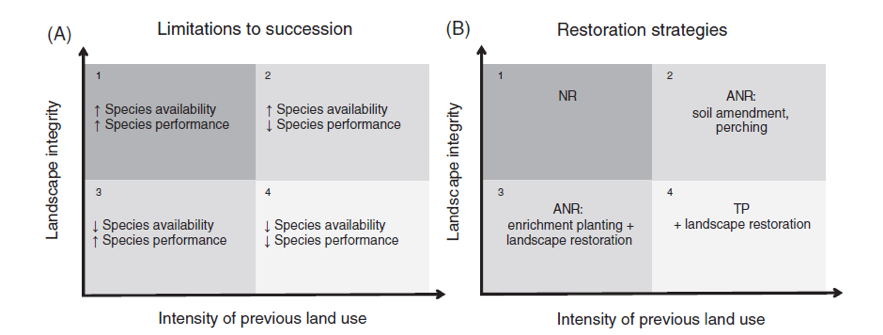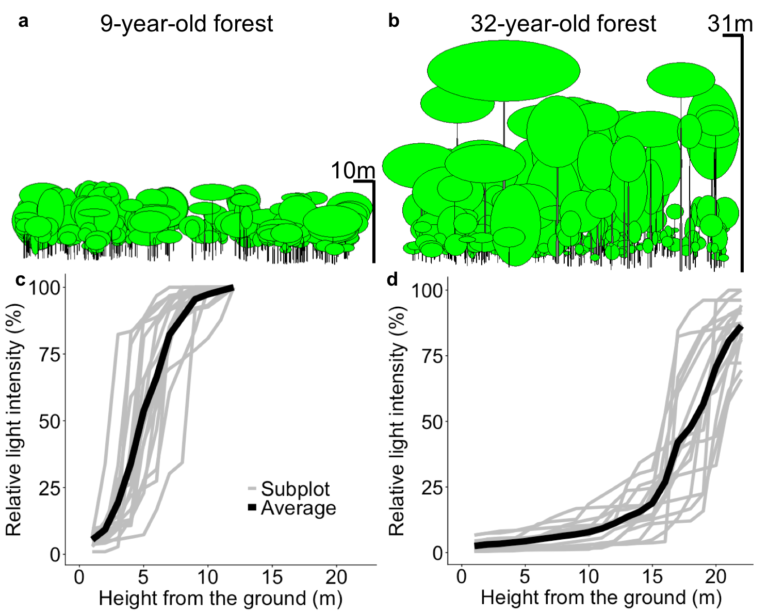Publications
Land use legacies affect early tropical forest succession in Mexico
Iris Hordijk, Lourens Poorter, Miguel Martinez-Ramos, Frans Bongers, Rey David López Mendoza, Pascual Jamangapé Romero, Masha van der Sande, Rodrigo Muñoz, Robyn Jansma, Natsuho Fujisawa, Jorge A. Meave
Applied Vegetation Science, 2024, doi: 10.1111/avsc.12784
Agricultural expansion is one of the dominant drivers of forest and biodiversity loss, and shifting cultivation is the most widely used form of agriculture in many tropical forest regions. Where forests have been cleared, they have the potential to recover once the land is abandoned. However, legacies of land use are often overlooked in successional studies, and a deeper understanding of this legacy effect is needed to define efficient restoration practices using natural or assisted regeneration.
Here, we analysed how land use history affects soil properties and early succession on abandoned agricultural fields in two contrasting Mexican socio-ecological systems. We sampled soil and monitored vegetation for two years after agricultural abandonment, and interviewed landowners about their land use practices.
We found that land use practices were clearly influenced by landowners’ social context (residence time, rural or urban origin), and topography and soil type also constrained or facilitated land use practices. Soil characteristics were strongly affected by three land use practices: mechanical tillage decreased soil N and K, frequent herbicide and pesticide use increased N and K, and for pasture systems stocking density increased soil bulk density and decreased pH and N. High-intensity land management practices, specifically use of machinery, had the highest impact on early forest succession. When machinery was not used, the frequency of land use practices, particularly weeding frequency, is the main factor influencing tree cover and sapling diversity.
To facilitate post-agricultural forest recovery, we recommend restoration efforts using natural regeneration in areas with low previous land use intensity and frequency.

Light competition drives species replacement during tropical secondary forest succession
Tomonari Matsuo, Miguel Martínez‑Ramos, Yusuke Onoda, Frans Bongers, Madelon Lohbeck, and Lourens Poorter
Oecologia, 2024, https://doi.org/10.1007/s00442-024-05551-w
The rationale. Light competition is thought to drive successional shifts in species dominance in closed vegetations, but few studies have assessed this for species-rich and vertically structured tropical forests.
Aims. We aim to understand how light competition drives species replacement during succession
Approach. We assessed how cross-species variation in relative biomass growth rate and light competition strategies (light interception efficiency and light use efficiency) is determined by underlying species functional traits.
Findings.
- Throughout succession, species with greater RGR (relative growth rates) attain higher dominance (i.e., the relative biomass of a species in a community).
- In early succession, species with higher LIE (light interception efficiency) and acquisitive trait values (e.g., large crown leaf mass and low wood density) attain higher RGR, and thus higher dominance.
- In later succession, species with higher LUE (light use efficiency) and conservative trait values (e.g., high wood density and leaf mass per area) attain higher RGR and thus higher dominance.
Implications. During succession, there is a shift in light competition strategies and their associated traits from high LIE and acquisitive traits in early succession to high LUE and conservative traits in later succession, which explains species replacement during succession.

Height growth and biomass partitioning during secondary succession differ among forest light strata and successional guilds in a tropical rainforest
Tomonari Matsuo, Frans Bongers, Miguel Martínez-Ramos, Masha T. van der Sande, and Lourens Poorter
Oikos, 2024, https://doi.org/10.1111/oik.10486
The rationale. In closed-canopy systems globally, plants exhibit intense competition for light, prioritizing vertical growth to attain elevated positions within the canopy. Light competition is especially intense in tropical rainforests because of their dense shaded stands, and during forest succession because of concomitant changes in vertical light profiles.
Aims. We evaluated how the height growth of individual trees differs among forest light strata (canopy, sub-canopy, and understorey) and successional guilds (early, mid-, and late successional species) during secondary succession in a Mexican rainforest.
Approach. We estimated two measures of height growth: absolute height growth (HGabs, cm year−1) calculated as the difference in tree height between two consecutive censuses, and biomass partitioning to height growth (HGbp, in kg kg−1 × 100) calculated as the percent. We, then, compared these two measures among trees in different forest light strata, successional guilds, and successional stages.
Findings.
- Absolute height growth is fastest for canopy trees, followed by sub-canopy and understory trees. Differences in height growth among forest strata and species lead to a greater variation in tree sizes and increased structural diversity during succession.
- Biomass partitioning to height growth was greater for understory and sub-canopy trees than for canopy trees, reflecting ontogenetic changes from growth for improving light conditions to persistence against drought and wind stresses.
- Height growth decreased for all forest strata with succession, leading to stabilizing stand size structure and reducing the rate of structural development.
Implications. Differences in absolute height growth among forest light strata and their shifts during succession lead to shape patterns in forest structural development. Biomass partitioning to height growth reflects both ontogeny and successional changes in height growth patterns of tree individuals.

Herbaceous species and dry forest species have more acquisitive leaf traits than woody species and wet forest species
Tomonari Matsuo, Masha T. van der Sande, Lucy Amissah, Jonathan Dabo, Salim Mohammed Abdul, and Lourens Poorter
Functional Ecology, 2024, https://doi.org/10.1111/1365-2435.14477
The rationale. Early biogeographers have classified plant species based on their woodiness, size, and lifespan into a few life forms, such as grasses, shrubs, and trees. This allows us to understand how life forms and their corresponding vegetation types such as savannas and forests, are distributed across space along a precipitation gradient, and over time when vegetation regrows after a disturbance (i.e., secondary succession).
Aims. We studied 324 species belonging to six common life forms (herbs, grasses, vines, lianas, shrubs, and trees) that occur during early forest succession on abandoned agricultural fields in dry and wet regions in Ghana.
Approach. We compared 324 early-successional species from six life forms (herbs, grasses, vines, lianas, shrubs, and trees) that occur in the first five years of succession on abandoned fields in Ghanaian wet and drought-deciduous tropical forests. We measured 12 important leaf traits for carbon, water, and nutrient use.
Findings.
- Herbaceous and woody life forms had different leaf economics strategies: herbaceous species had more acquisitive trait values (e.g., higher leaf nutrient concentrations) that increased resource capture and use efficiency whereas woody species had more conservative trait values (e.g., higher leaf mass per area) that increase resource conservation.
- Regardless of life forms, dry forest and deciduous species had more acquisitive trait values than wet forest and evergreen species as they maximize their growth during the shorter growing season.
- The trait hyperspace was larger for woody life forms, especially in wet forests.
Implications. Herbaceous species had ‘faster’ leaf economics trait values and rapid carbon gain, explaining their success earlier in succession. In contrast, woody species had ‘slower’ resource conservation trait values that increase persistence, thus explaining their success later in succession. Deciduous species especially in a dry region had higher leaf nitrogen and phosphorus concentration to attain faster carbon gain to cope with a seasonally harsh environment.

The role of land-use history in driving successional pathways and its implications for the restoration of tropical forests
Catarina C. Jakovac, André B. Junqueira, Renato Crouzeilles, Marielos Peña-Claros, Rita C. G. Mesquita and Frans Bongers
Biological Reviews, 2021, doi: 10.1111/brv.12694
Secondary forests are increasingly important components of human-modified landscapes in the tropics. Successional pathways, however, can vary enormously across and within landscapes, with divergent regrowth rates, vegetation structure and species composition.
We review the literature aiming to provide a comprehensive understanding of the mechanisms underlying the long-lasting effects of land use on tropical forest succession and to discuss its implications for forest restoration. We organize it following a framework based on the hierarchical model of succession and ecological filtering theory.
This review shows that our knowledge is mostly derived from studies in Neotropical forests regenerating after abandonment of shifting cultivation or pasture systems. The literature shows that (i) species availability to succession is affected by transformations in the landscape that affect dispersal, and by management practices and seed predation. Species establishment and performance are dependent on resistance to management practices, tolerance to (modified) soil conditions, herbivory, competition with weeds and invasive species, and facilitation by remnant trees. (ii) Structural and compositional divergences at early stages of succession remain for decades, suggesting that early communities play an important role in governing further ecosystem functioning and processes during succession. Management interventions at early stages could help enhance recovery rates and manipulate successional pathways. (iii) The combination of local and landscape conditions defines the limitations to succession and therefore the potential for natural regeneration to restore ecosystem properties effectively.

Forest structure drives changes in light heterogeneity during tropical secondary forest succession
Tomonari Matsuo, Miguel Martínez-Ramos, Frans Bongers, Masha T. van der Sande, and Lourens Poorter
Journal of Ecology, 2021, https://doi.org/10.1111/1365-2745.13680
The rationale. Light is a key resource for tree performance and hence, tree species partition spatial and temporal gradients in light availability. Although light distribution drives tree performance and species replacement during secondary forest succession, we yet lack understanding how light distribution changes with tropical forest development.
Aims. This study aims to evaluate how changes in forest structure lead to changes in the vertical- and horizontal light heterogeneity during tropical forest succession.
Approach. We described successional patterns in light using a chronosequence approach in which we compared 14 Mexican secondary forest stands that differ in age (8-32 years) since agricultural abandonment. For each stand, we measured vertical light profiles in 16 grid cells, and structural parameters (diameter at breast height, height, and crown dimensions) for each tree.
Findings.
- During succession, the inflection points of the vertical light gradient (i.e., the absolute height at which 50% relative light intensity is attained) rapidly moved towards higher heights in the first 20 years, indicating that larger amounts of light are intercepted by canopy trees.
- Light attenuation rate (i.e., the rate of light extinction) decreased during succession due to slower accumulation of the crown area with height.
- Understory light intensity and heterogeneity slightly decreased during succession because of an increase in crown size and a decrease in lateral gap frequency.
- Understory relative light intensity was 1.56% at 32 years after abandonment.
- These changes in light conditions are largely driven by the successional changes in forest structure, as basal area strongly determines the height where most light is absorbed, whereas crown area, and to a lesser extent crown length, determine light distribution.
Implications. The fast forest development during tropical secondary forest succession leads to the fast changes in light conditions and more light heterogeneity, which can increase the proportion of shade-tolerant late-successional species over time, and hence tree species diversity.
